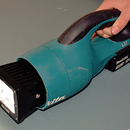Introduction: Bomb Proof Clock
When I'm woken up in the morning by the alarm, I'm not in the best of moods and the first thing to cop it is the bed side clock. Often its gets smacked, punched, thrown or kicked across the room or through the window, which can lead to the clock breaking.
What I need is a clock that can take a beating and come back for more. With its reinforced MIG welded 3mm steel case this clock can take what ever you throw at it.
Step 1: Stuff You Will Need
Ebay does a great little clock kit for only $3.00 It doesn't come with much in the way of instructions but the PCB is well labeled, and it is a reasonably simple kit to put together.
To assemble the kit you will need.
- Clock kit
- Soldering iron
- Solder
- Side cutters
- 5 volt plug pack / Or an old usb cable with a phone charger.
You will also need to be able to identify electronic components and understand if they are polarity sensitive and know how to read component values.
You will also have to have good soldering skills, as many of the pins are very close together and poor soldering will ruin your project very quickly.
To make the case bomb proof, you will need a bit of imagination, you can put you clock inside a steel tube or fold up some sheet metal.
If you not to fussed on making it "bomb proof" you could 3D print or laser cut a case from plastic.
Step 2: Can You Solder?
If you have never done any soldering before, this is not the project to practice on. A good way to learn to solder is practicing on a piece of vero board and some header pins.
Tips for good solder joins are.
- Make sure the soldering Iron is clean, melt a little solder on the tip and clean off with a wet sponge.
- Soldering iron need to be up to temperature before you start.
- Use proper resin core 60/40 electrical solder. (Lead free solder can be difficult to work with)
- Heat the pad and the wire with the solder iron
- Bring the solder in from the opposite side of the iron
- Melt the solder onto the pad and wire.
- Avoid putting the solder directly on the soldering iron when soldering
Step 3: Do You Know Your Componets?
Their are a number of components you need to get familiar with before you start you have to be able identify the components and understand if they are polarity sensitive and know how to read component values.
This can easily be done with a google search, here are some names to get you started
- Resistor
- ceramic capacitor
electrolytic capacitor
Transistor
crystal (electronic)
- PCB
- IC
- IC socket
- Resistor network
- Segment LED display
- Tactile Switch
- NO switch
Step 4: Making a Start
Start off by fitting the small components with long leads. If you look on the PCB they are clearly marked.
- The two 10k resisters fits in the "10K" box labeled R1 and R2, just thread the leads through the holes and bend them so they don't fall out
- The two 30pf ceramic capacitors are next and they are labeled C2 and C3
- The 0.10uf ceramic is next and is labeled C4
- Next the 10uf Electrolytic capacitor which needs to go in the correct way around, the white stripe is the negative lead. It fits in the PCB where is labeled C1
- The crystal can go in next in the box label 12M
- The transistor needs to go in the Q1 spot and the correct way around
- Your project should look like the last photo. Double check the you have everything in the right place before you start soldering.
Step 5: Soldering the PCB
Now you can carefully solder the leads on the back of the PCB. once soldered the leads can be cut off with a sharp set of side cutters.
Most faults on kit are a result of poor soldering so make sure you check for bad joins or missed solder leads before moving on to the next step.
Step 6: Fitting the Larger Componets
Next we can fit some of the larger more difficult components.
- Quite often on these large components some of the pins may be bent and will have to be straighten before they will fit into place
- The IC socket is next and this need to be fitted the correct way around. There is a notch in one end of the socket. and it fits in the space labeled 89C2051
- Check that all the pins are in the holes before you start soldering it is very easy to bend a pin, and very difficult to fix after it is soldered in place
- The resistor network can go in next and this has to be fitted the correct way around in the spot labeled PR1
- The two switches can go in the SW1 and SW2 spots and although they are not polarity sensitive it is still possible to put them in wrong. (90 degrees out) The pins will need a little bend to get them to fit into the PCB
- Once done you can solder these parts into place.
Step 7: Fitting the IC, LED Display and Buzzer
Normally you would fit the IC into it socket last, but can be a bit awkward to get your fingers around it with the LED display in place.
- The IC has to be fitted the correct way around. Often the pins are bent so the may have to be straightened before you attempt to push into the socket.
- It is easy to bend a pin while you are pushing the IC down so be very careful to watch all the pin as you put pressure on it
- The LED display can go in next in the big spot labeled DS1 and no it wont work if you put it in upside down.
- Again the pins can be bent so you may have to adjust them before you try and fit it to the PCB
- The buzzer can go in next and it has to go in around the right way. "Remove seal after washing" There is a joke in there somewhere....
- Finally the connector can go in the CON1 spot and it can all be soldered up. you project should look like the photos.
- The + and - for the power supply are on the back of the PCB
Step 8: Powering Up Your Clock
All going well you should be able to power up your clock and it should work. You have a number of options to power it but don't put any more than 6 volts into it or it will fry.
Option 1
Find an old plug pack if you read the label, somewhere it will tell you the output voltage you are looking for a 5 volt pack. Just cut of the end and strip the wires back you will find a red and a black. Red to Positive + and Black to negative - If you connect the wrong way around or use the wrong voltage your clock will most likely be damaged
Option 2
Find an old USB lead or a broken device with a USB cable you can snag. Just off the end and you will have four wires. Two of them will be 5 volts use a multi-meter to find the wires and the correct polarity and connect it up. I chopped a lead of an old mouse and the correct leads were orange and green. You can then pug this into a usb charger to power your clock.
Option 3
You could use your imagination, as long as you keep the voltage between 3 and 6 volts the clock will work correctly. Some ideas
- Battery
- Battery and solar panel
- Use voltage regulator and run it from a higher voltage, like your car.
- lemon power clock.
Step 9: Setting Your Clock
Setting you clock is pretty easy, but be aware that some of the alarm settings wont come up if you turn them off. Here is a quick run down.
Hold Switch one down for 2 seconds to enter the time setting mode and switch two to change the setting. Hit switch one again to scroll through each setting.
- "A" set the time in hours. This is a 24 hour clock.
- "B'" looks like an 8 but it sets the minutes
- "C" chime on or off
- "D" looks like an 0 turns alarm 1 on or off
- "E" alarm 1 hours set
- "F" alarm 1 minutes set
- "G" alarm 2 on or off
- "H" alarm 2 hours set
- "I" alarm 2 minutes set.
It also does this weird thing if you push switch 2 down while in time mode it will read the seconds and minutes of the hour.
Step 10: Moding Your Clock
You can do a couple of things to mod your clock, which could be worth while, the most useful would be putting some bigger more accessible switches to make it easier to set and turn the alarm off. And some sort of battery back up so when the power goes out, you don't have to reset the time.
- The two switches are push button NO or normally open switches and can be easily attached to the case by drilling a hole and screwing them in.
- The wires and switch terminals need to be "tinned" or pre-soldered and some shrink wrap fitted to help make the joint stronger.
- To heat the shrink wrap use the body of the soldering iron Not the tip as it will contaminant the tip and make it difficult to solder
- The wires can then be soldered on the back of the PCB as shown in the photos behind the tactile switches
- I used a 5.5 volt 1 farad super capacitor, to give it a battery back up, but it will only last about 2 minutes, so its ok if you have a short power cut, or you want to move the clock to another room.
- The capacitor is polarity sensitive so make sure it is wire around the right way.
- Use a little heat shrink and solder the leads on the back of the PCB behind the connector.
- Alternatively you could wire up a rechargeable battery, but it will only last a few hours.
Step 11: Making a Case
This is where you can let your imagination go nuts. In a world where most electronic devices are plastic, it quite cool to have a heavy, metal digital bed side clock.
The simplest case would be to cut a piece off RHS and block on end off. Drill a hole for the lead and two for the switches and fit the clock inside. A piece of acrylic finishes the front off.
But you could also make it out of a pipe, aluminum extrusion, sheet metal, or junk if you wanted. Have a look in the scrap pile and see what you can dream up.
After looking through the scrap pile I found a piece of RHS only just big enough for the clock to fit into, so it was a real challenge to get every thing into the case. You may want to make you clock a little bigger as it would be much easier to assemble
For this case I
- Cut a piece of RHS off in the vertical band saw
- Filed all the sharp edges, to make everything smooth
- Marked out with a scriber the 3mm flat to fit in the back
- Cut the back out with a jig saw and a metal blade. You have to use a lubricant to keep the blade cool
- Got the back to fit in the hole by filing the corners.
Step 12: Welding and Grinding the Case
Once you get the back fitting, you can put the case on a flat surface and tack weld it on from the inside, the clock can then be turn over and welded from the outside.
You can then grid the weld back flat and then finish it off by polishing it with a flapper disc.
Step 13: Drilling the Holes for the Buttons and Lead
Next up you can drill a couple of holes for the buttons to fit and one for the lead. Make sure that you remove the sharp edges around the holes or the lead may be damaged.
Once you get to this stage and you are confident every thing is going to fit , you may which to paint your case, or give it a coat of clear if you want it to stay shiny
Step 14: Fitting the Clock to the Case
As I made this case so small it was quite difficult to get every thing to fit inside. Also the clock PCB only has one mounting hole which is not very helpful. Double sided foam tape can be used and it is very strong, Ive used a small block of wood to space out the clock, but a piece of sheet metal would also work well.
The lead needs something to prevent it been pull out of the clock case, a cable tie or simply putting a knot in the lead will fix that problem.
Step 15: Making and Fitting the Face
Now you have the clock in it case its time to make a face. I made it from dark tinted acrylic so it looks black apart from the numbers, but you can make it from any colour you like.
- First carefully measure the size you need and, draw up a rectangle in a cad program and round the corners to around 5 mm.
- You need draw the face around 0.5 mm smaller than the opening, as it will need a little clearance to fit
- Once cut out with the laser cutter, some scrap can be cut to support and locate the face.
- The double sided foam tape can then be use to stick the scrap pieces to the case.
- You can see in the photos I relocated one of the supports as it was covering the numbers a little
- Once the supports are in position tape can be removed the backing from tape can be removed and every thing can be stuck in place
- You can now put it beside you bed and set the alarm, knowing that if you hit it too hard you will only break your hand!
How did you go? There is an evaluation sheet, that you can use to help document your work and think about new skills you have learned while constructing your clock.
Attachments

Participated in the
Home Hacks Challenge

Participated in the
Big or Small Challenge














